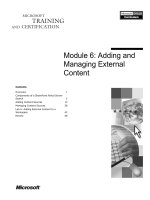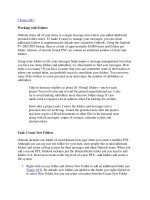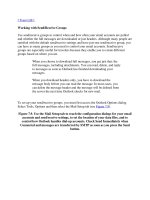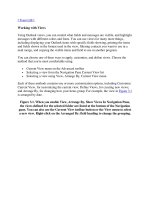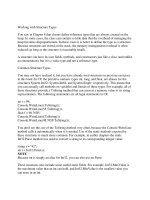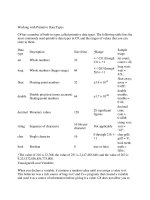Tài liệu Working with Wireframe and Surface Design Workbench doc
Bạn đang xem bản rút gọn của tài liệu. Xem và tải ngay bản đầy đủ của tài liệu tại đây (852.56 KB, 40 trang )
Chapter
9
Working with Wireframe
and Surface Design
Workbench
After completing this chapter you will be able to:
• Create wireframe geometry.
• Create extruded surfaces.
• Create revolved surfaces.
• Create spherical surfaces.
• Create offset surfaces.
• Create swept surfaces.
• Create fill surfaces.
• Create loft surfaces.
• Create blend surfaces.
• Split surfaces.
• Trim surfaces.
• Join surfaces.
Learning Objectives
Evaluation chapter. Logon to www.cadcim.com for more details
9-2 CATIA for Designers (Evaluation Chapter F007/004)
Evaluation chapter. Logon to www.cadcim.com for more details
NEED OF SURFACE MODELING
The product and industrial designers these days are giving importance to product styling
and providing a unique shape to components. Generally, this is done to make sure that the
product looks attractive and presentable to the customer. The shape of products are
managed using the surface modeling techniques. Surface models are three-dimensional models
with no thickness and unlike solid models, they do not have mass properties. CATIA V5
provides a number of surface modeling tools to create complex three-dimensional surface
models. Various workbenches in CATIA V5 with surface creation tools are:
1. Wireframe and Surface Design.
2. Generative Shape Design.
3. FreeStyle.
In this textbook, you will learn about the surface modeling tools available in the Wireframe and
Surface Design workbench.
WIREFRAME AND SURFACE DESIGN WORKBENCH
The Wireframe and Surface Design workbench provides the tools to create wireframe
construction elements during preliminary design and enrich existing 3D mechanical part
design with wireframe and basic surface features.
Starting Wireframe and Surface Design Workbench
Start a new session of CATIA and close the new product file, which is opened by default.
Next, choose Start > Mechanical Design > Wireframe and Surface Design from the menu
bar to start a new file in the Wireframe and Surface Design Workbench.
CREATING WIREFRAME ELEMENTS
The wireframe construction elements aid in creating surfaces. The sketches drawn in sketcher
workbench can also be used to create surfaces. The tools available for constructing the
wireframe geometries are discussed in the following section.
Creating Circles
The Circle tool is used to create circular arcs and circles. Choose the Circle button
from the Wireframe toolbar; the Circle Definition dialog box is displayed, as shown
in Figure 9-1. The Center and radius option is selected by default in the Circle type
drop-down list; you are prompted to select the center point. You can select a predefined
point or create a point by choosing any one of the options from the contextual menu, which
is available when you right click on the Center selection area of the Circle Definition dialog
box. Next, you are prompted to select the support surface. Select a plane as the support
surface. Specify the required radius value in the Radius spinner. You can set the angular
limits of the arc from the Circle Limitation area and finally choose the OK button to
complete the arc .
Menu: Insert > Wireframe > Circle
Toolbar: Circle-Corne... >Circle
Working with Wireframe and Surface Design Workbench 9-3
Evaluation chapter. Logon to www.cadcim.com for more details
The other tools such as Corner, Connect Curve were discussed in the earlier chapters.
Creating Splines
The Spline tool is use to draw a spline in three dimensional space by selecting the
connecting points. Choose the down arrow on the right of the Spline button to
invoke the Curves toolbar, as shown in Figure 9-2, and then choose the spline button.
The Spline Definition dialog box, as shown in Figure 9-3, is displayed and you are prompted
to select a point. You can select a predefined point or create a point using the options from
the contextual menu, which will be displayed when you right-click in the Points selection
area of the dialog box. Once you have selected a point, you are further prompted to select a
point or a direction (line or plane) or a curve. You can choose a number of points to draw the
spline.
In the Spline Definition dialog box, Geometry on Support check box is provided. On selecting
this check box you are prompted to select a support element. Select a plane or a surface such
that the point defined for spline creation lies on it. The spline thus created will lie completely on
the defined support element. Choose OK button from the dialog box to complete the spline.
Menu: Insert > Wireframe > Spline
Toolbar: Curve > Spline
Figure 9-2 The Curve toolbar
Figure 9-1 The Circle Definition dialog box
9-4 CATIA for Designers (Evaluation Chapter F007/004)
Evaluation chapter. Logon to www.cadcim.com for more details
Creating Helix
The Helix tool is used to create a helical curve. When you invoke this tool, the Helix
Curve Definition dialog box will be displayed, as shown in Figure 9-4, and you are
prompted to select the helix starting point. Select a predefined point, or create a
point using the options from the contextual menu, which will be displayed when you right
click on the Starting point selection area of the Helix Curve Definition dialog box. Next,
you are prompted to select a line as the helix axis. Select a predefined line or draw a line
using the options from the contextual menu, which will be displayed when you right-click in
the Axis selection area. You can set the pitch, height, orientation, and start angle values in
the respective spinners. You can also add a taper angle to the helix by specifying a value in
the Taper Angle spinner available in the Radius variation area of the dialog box. Figure 9-5
shows a helix without a taper angle and Figure 9-6 shows a helix with a taper angle.
CREATING SURFACES
The tools provided in Wireframe and Surface Design workbench to create simple and
complex surfaces are discussed in the following section.
Creating Extruded Surfaces
The extruded surfaces are created by extruding a profile and specifying the
extrusion depth and direction vector. The basic parameters that are required to
Menu: Insert > Wireframe > Helix
Toolbar: Curve > Helix
Menu: Insert > Surfaces > Extrude
Toolbar: Surfaces > Extrude
Figure 9-3 The Spline definition dialog box
Working with Wireframe and Surface Design Workbench 9-5
Evaluation chapter. Logon to www.cadcim.com for more details
create an extruded surface are profile, direction for extrusion, and extrusion limits. To create an
extruded surface, you first need to draw the profile to be extruded using the Sketcher
workbench or by using the tools available in the Wireframe toolbar. Once you have drawn
the profile, choose the Extrude button from the Surfaces toolbar; the Extrude Surface
Definition dialog box is displayed, as shown in Figure 9-7.
If the profile is selected before invoking this tool, the preview of the extruded surface is
displayed in the geometry area. Otherwise you are prompted to select the profile to be
extruded. Select a profile to be extruded. If you draw the profile using the tools from the
Wireframe toolbar, then you are prompted to specify the direction for extrusion. Specify the
Figure 9-4 The Helix Curve definition dialog box
Figure 9-5 The helix without specifying the taper
angle
Figure 9-6 The helix with specified taper
angle
9-6 CATIA for Designers (Evaluation Chapter F007/004)
Evaluation chapter. Logon to www.cadcim.com for more details
direction by selecting a plane normal to the profile. You can also specify a line, or an axis for
specifying the direction for extrusion. Set the extrusion limits in the Limit spinners. Figure 9-8
shows the profile to be extruded and Figure 9-9 shows the resulting extruded surfaces.
Creating Revolved Surfaces
Revolved surfaces are created by revolving a profile about a revolution axis. To create
a revolved surface, first sketch the profile and revolution axis around which the profile is
to be revolved. Choose the Revolve button from the Surfaces toolbar; the
Revolution Surface Definition dialog box is displayed, as shown in Figure 9-10.
Figure 9-8 The profile to be extruded
Figure 9-9 The resulting extruded surface
Tip. You can also select an edge of an existing surface or a solid body as the profile
to create an extruded surface.
Figure 9-7 The Extruded Surface Definition dialog box
Menu: Insert > Surface > Revolve
Toolbar: Surface > Revolve
Working with Wireframe and Surface Design Workbench 9-7
Evaluation chapter. Logon to www.cadcim.com for more details
Select the profile to be revolved. By default, the axis you sketched, with the profile in the
sketcher workbench, is selected as the axis of revolution. You can also select some other axis
of revolution. Now, set the required angular limits in the Angle spinners. Figure 9-11 shows
a profile and an axis of revolution to create the revolve surface. The resulting surface,
revolved through an angle of 180-degree, is shown in Figure 9-12.
Creating Spherical Surfaces
This tool is used to create the spherical surfaces. When you invoke this tool, the
Sphere Surface Definition dialog box is displayed, as shown in Figure 9-13. You need
to select the center point and an axis system as the sphere axis. You can select an
existing point as the center point or create a point by using the options from the
contextual menu, which will be displayed on right-clicking in the Center selection area. The
Default(xyz) axis system is automatically selected. You can also select any previously created
axis system. The preview of the spherical surface is displayed in the geometry area. You can
Figure 9-10 The Revolution Surface Definition dialog box
Figure 9-11 The profile and revolution axis
Figure 9-12 Surface revolved through an angle of
180-degree
Menu: Insert > Surfaces > Sphere
Toolbar: Surfaces > Sphere
9-8 CATIA for Designers (Evaluation Chapter F007/004)
Evaluation chapter. Logon to www.cadcim.com for more details
vary the angle values using the options available in the Sphere Limitations area or by
directly dragging the limiting arrows in the geometry area. Figure 9-14 shows the
spherical surface created by defining the origin as the center. Also, this surface has the default
axis system and sphere limitation values.
Figure 9-14 A spherical surface
Figure 9-13 The Sphere Surface Definition dialog
Tip. You can create complete sphere using the Sphere button available in the
Sphere Limitations area of the Sphere Surface Definition dialog box.
Working with Wireframe and Surface Design Workbench 9-9
Evaluation chapter. Logon to www.cadcim.com for more details
Creating Cylindrical Surfaces
This tool is used to create cylindrical surfaces. Choose the Cylinder button from
the Surfaces toolbar; the Cylinder Surface Definition dialog box is displayed and
you are prompted to select the center of the cylinder. You can select an existing point
as the center point or create a point by using the options from the contextual menu, which
will be displayed on right-clicking in the Center selection area. Next, you are prompted to
specify the direction for the cylinder. Select a plane, normal to which the cylinder will be
extruded. You can also select a direction vector from the contextual menu, which can be
invoked by right-clicking in the direction selection area. Set the parameters using the
spinners in the Parameters area in the Surface Definition dialog box. Choose OK to create the
cylindrical surface.
Creating Offset Surfaces
The Offset tool is used to create a surface that is at an offset distance from a reference
surface. To do so, choose the Offset tool from the Surfaces toolbar. The Offset
Surface Definition dialog box is displayed, as shown in Figure 9-15, and you are
prompted to select a reference surface.
Select the reference surface from the geometry area and specify the offset value in the Offset
spinner. Choose the Reverse Direction button available in the dialog box to reverse the offset
direction. The Both sides check box is selected to create the offset surface on both sides of the
reference surface. The Repeat object after OK check box is used to create multiple offset surfaces.
Select the Repeat object after OK check box and exit the Offset Surface Definition dialog box.
The Object Repetition dialog box is displayed, as shown in Figure 9-16.
Menu: Insert > Surfaces > Cylinder
Toolbar: Surfaces > Cylinder
Menu: Insert > Surfaces > Offset
Toolbar: Surfaces > Offset
Figure 9-15 The Offset Surface Definition dialog box
9-10 CATIA for Designers (Evaluation Chapter F007/004)
Evaluation chapter. Logon to www.cadcim.com for more details
In this dialog box specify the required number of intance(s). Choose the OK button to create
the offset surfaces. Figure 9-17 shows a reference surface and an offset surface.
Note
Sometime for complex reference surfaces, the offset surface may not be created. In such cases, you
need to reduce the offset value or modify the initial geometry.
Creating Swept surfaces
The swap tool is provided to create surfaces by sweeping a profile along a guide curve
in the Wireframe and Surfaces Design workbench of CATIA V5. To create a swept
surface, you first need to draw a profile and a guide curve as two separate sketches.
Next, choose the Sweep button from the Surfaces toolbar. The Swept Surface Definition dialog
box is displayed, as shown in Figure 9-18, and you are prompted to select a profile. Select the
profile from the geometry area; you are prompted to select a guide curve. Select the guide
curve from the geometry area. Now, choose the OK button from the Swept Surface
Definition dialog box. Figure 9-19 show a profile and a guide curve and Figure 9-20 shows
the resulting swept surface.
Menu: Insert > Surface > Sweep
Toolbar: Surface > Sweep
Figure 9-17 An offset surface
Figure 9-16 The Object Repetition dialog box
Working with Wireframe and Surface Design Workbench 9-11
Evaluation chapter. Logon to www.cadcim.com for more details
Figure 9-18 The Swept Surface Definition dialog box
Figure 9-19 The sweep profile and guide curve
Figure 9-20 The resulting swept surface
Tip. Sometimes the swept surface may not be created, as the created geometry forms
a cusp. In such a case, reduce the curvature of the guide curves.
9-12 CATIA for Designers (Evaluation Chapter F007/004)
Evaluation chapter. Logon to www.cadcim.com for more details
Various other tools to create swept surfaces are discussed in the following section.
Swept Surface with two Guide Curves
You can also create a swept surface using more than one guide curve. First draw a profile and
two guide curves as separate sketches. Now, select the Sweep button from the Surfaces toolbar,
the Swept Surface Definition dialog box is displayed. Select With two guide curve option
from the Subtypes drop-down list; you are prompted to select a profile. After you select the
profile, you are prompted to select a guide curve. Select the first and second guide curves.
Now, select the anchor point for the respective guide curves. Choose the Preview button
from the Swept Surface Definition dialog box to preview the surface created. Choose the
OK button from the Swept Surface Definition dialog box. Figure 9-21 shows a profile and
guide curves. The swept surface created using the two guide curve is shown in Figure 9-22.
Swept Surface with Two Limits
In CATIA V5, you can create a swept surface by defining the two limit curves. The limit
curves can be in the same or different planes. To create swept surface with two limits, you
need to draw two limit curves. Once you have drawn the curves, choose the Sweep button
from the Surfaces toolbar; the Swept Surface Definition dialog box will be displayed. Select
the Line button from the Profile Type area in the dialog box. The parameters in the Swept
Surface Definition dialog box change and will appear as shown in Figure 9-23. You are
prompted to select the first guide curve. After selecting the first guide curve, you are prompted
to select a second guide curve. Select the second guide curve and choose the Preview button
to display the swept surface created between the limiting curve. Note that in the Optional
elements area, guide curve 1 is selected by default in the Spine selection area. You can select
another curve to be define as spine. Choose the OK button from the dialog box to create the
swept surface. Figure 9-24 shows the limit curves and Figure 9-25 shows the resulting surface.
Swept Surface with Three Curve
You can also create a circular swept surface using three guide curves. To create a surface using
this tool, you first need to draw three guide curves, which should lie in different planes. After
drawing the curves, invoke the Swept surface Definition dialog box. Choose the Circle
button from the Profile type area in the dialog box. The parameters in the Swept surface
Figure 9-21 The sweep profile and guide curves
Figure 9-22 The resulting swept surface
Working with Wireframe and Surface Design Workbench 9-13
Evaluation chapter. Logon to www.cadcim.com for more details
Definition dialog box will change, as shown in Figure 9-26. You are prompted to select a first
guide curve that define the first extremity of the circular arc. Select the first guide curve.
Next you are prompted to select the second guide curve. After selecting the second guide
curve, you are prompted to select a guide curve that defines the second extremity of the
circular arc. Select the guide curve and choose the OK button from the dialog box to
complete the swept surface. Figure 9-27 shows the guide curves and Figure 9-28 shows the
resulting swept surface.
Figure 9-23 The Swept Surface Definition dialog box
Figure 9-24 The sweep profile and guide curves
Figure 9-25 The resulting swept surface
9-14 CATIA for Designers (Evaluation Chapter F007/004)
Evaluation chapter. Logon to www.cadcim.com for more details
Creating Fill Surfaces
The Fill tool allows you to create fill surfaces between a number of boundary segments.
These may be planar or non-planar, but there should not be a large gap between the
consecutive boundary segments. Before creating a fill surface, draw the boundary curves.
Next, choose Fill button from the Surface toolbar. The Fill Surface Definition dialog box is
displayed, as shown in Figure 9-29.
Figure 9-26 The Swept Surface Definition dialog box
Figure 9-27 The guide curves
Figure 9-28 The resulting swept surface
Menu: Insert > Surfaces >Fill
Toolbar: Surfaces >Fill
Working with Wireframe and Surface Design Workbench 9-15
Evaluation chapter. Logon to www.cadcim.com for more details
Next, you are required to select the boundary segments. You need to make sure that while
selecting the boundary segments, the sequence of selection should be such that a closed loop
is formed. Once you have selected the boundary curves, choose the OK button. Figure 9-30
shows the curves drawn to create the fill surface and Figure 9-31 shows the resulting fill
surface.
Support surfaces may be selected with the respective curve to ensure the continuity between
the fill surface and the support surface. Similarly, if you select a passing point, the fill surface
will be created, such that it passes through the selected point.
Figure 9-29 The Fill Surface Definition dialog box
Figure 9-30 The Boundary curves
Figure 9-31 The resulting fill surface
9-16 CATIA for Designers (Evaluation Chapter F007/004)
Evaluation chapter. Logon to www.cadcim.com for more details
Figure 9-32 The Multi-sections Surface
Definition dialog box
Creating Lofted Multisection Surfaces
This tool allows you to create lofted multisection surfaces. The surface is created
between the sections along the computed or user-defined spine. To create a
multisection surface, you first need to create sections and guide curves. Next, choose
the Multisections surface button from the Surface toolbar; the Multi-sections Surface
Definition dialog box is displayed, as shown in Figure 9-32.
You are prompted to select a curve. Select the first section curve; you are prompted to select
new curve or select a tangent surface. Select the second section curve from the geometry area
and click on the Guide selection area to activate it. You are prompted to select a curve. One
by one, select the guide curves that were drawn earlier. Choose the OK button to exit the
Multi-sections Surface Definition dialog, box and complete the multi section surface.
Figure 9-33 shows sections and guide curves to create the multisection surface and
Figure 9-34 shows the resulting surface.
Note
While selecting the section curve, make sure the arrow associated with each section curve is
pointing in the same direction. Else, the surface will result in a cusp and will not be created. In
some cases, with arrows pointing in opposite direction, a twisted surface may be formed.
Menu: Insert > Surface > Multisections surface
Toolbar: Surface > Multisections surface
